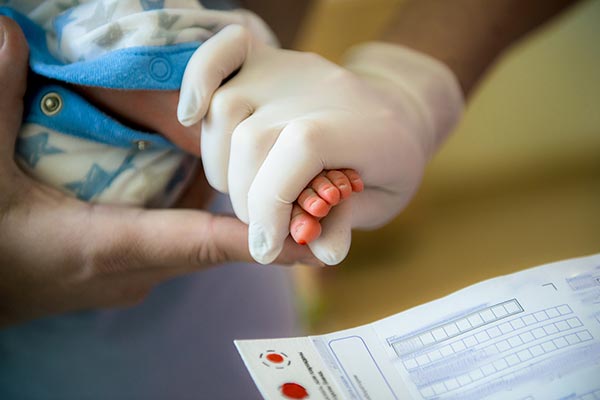Recent Posts
THE STORY OF MY WILSON DISEASE: AGE 8 TO 53
By Barbara Noci I was born on the 6th of April 1972 in Empoli, a little city near Florence in [...]
Travis’s Story of Wilson Disease
Rare and Rural By Rhonda Rowland, WDA President We all love a small town. Images come to mind of holiday [...]
Newborn Screening for Wilson Disease
A 25-year dream coming close to reality By Alice Williams, WDA Communications Director Since the 1960s, the United States has [...]
Can Copper be Absorbed Through the Skin?
By Edward Tabor, MD, WDA Board Member The main source of copper for humans is food, and Wilson disease patients [...]
They Said “Yes” to Gene Therapy
By Rhonda Rowland, WDA PresidentWe continue the story of two trailblazers who are among the first Wilson disease (WD) patients [...]
Meet the Inaugural Gene Therapy Candidates
By Rhonda Rowland, WDA President The two gene therapy clinical trials for Wilson disease (WD) launched by Ultragenyx and [...]
Meet the Inaugural Gene Therapy Candidates
By Rhonda Rowland, WDA President
The two gene therapy clinical trials for Wilson disease (WD) launched by Ultragenyx and Vivet Therapeutics are underway! Here, we introduce the WD community to two people who are trailblazers in these studies that will show us if gene therapy works as a treatment for the rare genetic liver disease. Emily signed up for the Ultragenyx trial, and Warren volunteered for the Vivet trial.
They are both in their 40’s. Both are married with a young child, and they both live east of the Mississippi and north of the Mason-Dixon Line. They’re both Caucasian, brunette and wear glasses. They’re the only ones in their respective families with WD. And both were diagnosed from the copper deposits found in their corneas, called Kayser-Fleischer rings.
Aside from having these things in common, their WD journeys are vastly different. Each appeared happy and healthy when interviewed over Zoom.
Meet Emily

“I’m about to cry, because it was such a meaningful day for me,” she recalls.
A few years before, Emily was approaching her wedding day and noticed tremors in her hand. She chalked it up to wedding planning and work stress.
“We got through the wedding and things didn’t get any better,” said Emily. “My tremors had moved from my hands to my feet, I was getting unsteady and would sometimes fall.”
She continued to chalk up her symptoms to the stress of being a newlywed, moving into a new house and balancing a full-time job. When her tremors got so bad that she had difficulty eating, she went to her family physician, who referred her to a local neurologist. He misdiagnosed her with early-onset Parkinson disease.
“I was devastated. I thought my husband would leave me,” said Emily.
She was prescribed medication for Parkinson’s, which didn’t help. Her symptoms deteriorated to the point where she had to quit her job, stop driving and have relatives stay with her while her husband worked because it wasn’t safe to be alone. She started slurring her speech. She experienced mood swings and was depressed. “It was horrendous,” she recalls. “I went back to the neurologist, who then changed the diagnosis to some sort of psychiatric or conversion disorder. It was infuriating because I wasn’t making this up, and knew I couldn’t control my movements.”
Emily returned to her family physician, who then referred her to a movement disorders specialist at Indiana University Medical Center (IU).
“He said, ‘I think I’m onto something. I think you have Wilson disease, I’ll be back in 20 minutes,’” recalls Emily.
During that time her husband searched for Wilson disease on his phone. “He said, ‘You’re poisoned by copper. It’s nothing you’ve done. It’s hereditary.’” The doctor returned with a team of medical students and other doctors and asked if they could look into her eyes to confirm the diagnosis.
“At that point I was in a wheelchair and couldn’t even hold a water bottle. They wheeled me down the hall to look in my eyes with a special lamp,” said Emily. “Sure enough! Kayser-Fleischer rings right there. I was not crazy, I was not making it up. There was a treatment, not a cure, but there was hope. Best birthday present I ever got!”
Meet Warren

“At the time, I believe I was one of the youngest Wilson patients ever diagnosed,” said Warren.
He was in second grade when he started coming home from school feeling lethargic.
“I’d take a nap, eat, do my homework and immediately go to bed,” recalls Warren. “I did this for two or three weeks.”
His pediatrician was bewildered, so he referred Warren and his parents to UNC Chapel Hill Medical Center. Over the course of several days, doctors tested him for chronic mono, spinal meningitis, Lyme disease and more.
“Then a young doctor – he must have been a resident at the time because he’s still there – said ‘I just read this medical journal article about Wilson’s. He’s too young to have it, but let’s just rule it out,’” recalls Warren. “They sent me down to the eye doctor, and he immediately called down the other doctors. I had Kayser-Fleischer rings!”
Additional lab tests confirmed the diagnosis of WD, and he was prescribed the chelator, penicillamine. He’s been on that medication ever since.
“I led a very normal childhood and adolescence. I graduated high school and I was very active. I did everything a normal kid would do, I just had these pills I had to take every day,” recalls Warren.
Warren was also a rule follower when it came to avoiding copper in his diet.
“I cut out anything high in copper. I never had nuts, shellfish, chocolate, peanut butter. I followed that, even if I missed an occasional medication dose, and to this day I don’t have a sweet tooth for chocolate,” he said.
Warren’s life continued on a normal trajectory. He went to college close to home at Appalachian State University, and about halfway through he struggled in choosing a major. He volunteered as an EMT and considered something in healthcare. Instead, he chose to become a pastor.
“It wasn’t an aha moment,” said Warren, “I’ve just always been involved in the church, and I’m outgoing, a very extreme extrovert. It was kind of inevitable.”
He started seminary in the northeast, but decided to finish closer to home. He transferred to Duke Divinity School, where he met his wife. From there, they both worked as pastors in the Methodist church, and had a daughter who is now 11.
Then, overnight, everything changed for Warren.
Emily’s experience with her WD treatment
Once Emily got her WD diagnosis, everything fell into place.
“A slew of information came in from the physicians, the eye people, the liver people, the dietitian, the PT, the OT,” recalls Emily. She was put on the chelator, trientine. “My doctor said, ‘we can put you on penicillamine, that’s what most people start with, but you’ll most likely get worse before you get better on that drug.’” Because of that experience, some doctors prescribe trientine “off-label”, which is an unapproved use of an approved drug. “He did an appeal with the insurance company and got it approved.”
While no promises were made for how much her neurological symptoms would improve, Emily made a slow and steady return to normal by faithfully following her doctors’ care plan.
“Every day I would sit at home, praying for the day that I could get up, get showered, drive to a job, be productive, come home and do all the normal laundry, cooking, that sort of thing,” said Emily. “It took about a year and a half before I could drive myself and look for a part-time job.”
Eventually, she returned to full-time work as a secretary at an elementary school. She also gave birth to her son, now four years old. With all of her neurological symptoms gone, her biggest struggle became keeping up with her multiple daily doses of trientine, which must be refrigerated.
“With my job, my midday dose was at 2:30, which is dismissal time for my students. So my phone alarm would go off, and then I’d get busy with the kids who missed the bus and any other thing that came up,” said Emily. “Then I’m driving home and realize it’s still in my lunchbox.” Taking it later meant not eating with her family. “It really is a hassle.”
And then there’s the cost. Even with her husband’s good insurance from his welding job at a major automotive plant, the co-pay is burdensome when juggling daycare costs, a mortgage and two car payments.
“The problem I had most frequently is getting a pharmacy in my area to take the risk of filling the medicine because it’s so expensive,” said Emily. She also couldn’t count on the pharmacy storing it properly. “They’d pull it off the shelf and I’d refuse it, because it wasn’t refrigerated.”
She’s only been living with her diagnosis of WD for seven years – what does she miss from her life before her diagnosis?
“I miss having coffee with cream and sugar first thing in the morning,” said Emily. A simple pleasure.
Then one day, when all was going well, she got a call and had a decision to make.
Warren’s experience with his WD treatment
Warren had been taking penicillamine faithfully for more than 30 years. He never experienced medication side effects and lived a normal, healthy life. Then, about a decade ago…
“I woke up in the middle of the night and had a type of seizure,” recalls Warren. “I didn’t know my name, didn’t know where I was, didn’t know who my wife was, I didn’t know anything.” He was rushed to the emergency room where the ER physician assumed he was drunk. “They did a CT scan and saw that I had brain atrophy. I got connected with my first neurologist.”
Then major tremors set in.
“I couldn’t play guitar anymore, couldn’t type and had to use a voice recognition program,” recalls Warren. “I do needlepoint as a craft, couldn’t do that. Anything with fine motor skills was out. It got so bad that I was using weighted silverware.”
The neurologist prescribed various medications to treat the tremors, and he went to physical therapy. Still, Warren’s symptoms got worse. He had trouble with his gait, developed a stutter and struggled with impulse control and anger management.
Why would someone who had successfully managed their WD for decades suddenly take such a dramatic turn for the worse? The answer: Prior to his traumatic middle-of-the-night incident, Warren had cut his penicillamine dose in half. Again, why?
“The expense,” he says.
Between 2010 and 2015, the cost of penicillamine had increased from about $93 a month to $26,189 a month – a staggering increase of 5,787%. Adding to the astronomical, rapid increase in drug cost was an uninformed doctor.
“My primary care doctor said, ‘Your liver numbers are fine, sure, you can cut your penicillamine dose in half,’” said Warren. The doctor monitored him for six months and said his liver function tests still looked fine. But neurologically, Warren was not fine.
“The neurologist finally said, I’ve done all that I can, but I found you a specialist,” said Warren. He referred him to Dr. Michael Schilsky at Yale’s WD Center of Excellence. “Dr. Schilsky immediately put me back up to my original dose of penicillamine. He told me that the copper likely stayed mostly out of my liver, but instead, crept into my brain and affected my neurological functions.”
Dr. Schilsky told him that once you find your maintenance dose, that’s your dose for life.
“Had I not cut my dose in half, I probably would still be preaching,” said Warren.
Warren has been on disability, and had to give up preaching and his leadership roles in the Methodist church since his neurological symptoms set in.
While it’s not what he would have chosen, Warren is seeing that being on disability has given him time — lots of time — for a different kind of mission.
In the next issue of the Copper Connection, we’ll continue Warren and Emily’s stories and share more about their decisions to participate in the gene therapy trials.
For more information about the trials, check out their websites:
https://www.ultragenyx.com/our-research/our-pipeline/ux701-for-wilson-disease/
https://www.vivet-therapeutics.com/pipeline/wilsons-disease-at-a-glance/
The latest information on the trials can be found at:
www.clinicaltrials.gov Search: Wilson disease
https://wilsondisease.org/get-involved/participate-in-study/








